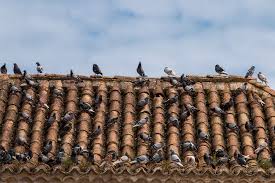
by Pigeon Patrol | Apr 26, 2021 | Bird Law, Pigeon Control, Pigeon Predators, Pigeon Spikes
Probably the second-worst thing that ever happened to pigeons was Woody Allen calling them “rats with wings” in 1980, prompting a bad reputation that the birds just haven’t been able to get rid of. (The worst thing that ever happened to pigeons was the extinction of the carrier pigeon in the late 1800s/early 1900s. These pigeons once existed in such multitudes, they would darken the sky for hours as they flew overhead; sadly, their sheer numbers led to a carefree attitude in hunting them, and they went from a population of millions to zero in a short time span.)
Contrary to popular belief, pigeons are quite interesting, useful animals. They were domesticated thousands of years ago (Darwin, in fact, was a little obsessed with pigeons), can be trained as athletes (called “racing pigeons”), mate for life (aww!), and have evolved to be able to digest a much wider variety of food than their ancestors. More recently, scientists in the U.S. and England have utilized pigeons to help collect data on air quality by strapping tiny, pigeon-sized backpacks onto the pigeons’ backs and tracking the data as the birds fly around.
They’re more reliable than your car’s GPS
Probably one of the most famous cool things about pigeons is their ability to always find their way home. You’ve probably heard of “homing pigeons” before, right? But how do they do it? Past studies have investigated the roles of olfactory cues, sun and magnetic compasses, and the use of long, linear landmarks such as roads, railway lines, and rivers. Interestingly enough, despite hundreds of years of research on the matter, there still doesn’t appear to be a consensus on how exactly pigeons have such an uncanny sense of direction.
In 2013, a study in the Journal of Experimental Biology found that homing pigeons use low-frequency sound waves, called infrasound waves, to make an acoustic mental map of their location. The researcher examined 14 years’ worth of data from 45,000 pigeons to determine that the only times the birds got lost were when these infrasound waves, due to wind or difficult terrain, were unable to reach the pigeons’ home loft. This sound block appears to have inhibited the birds’ ability to figure out their orientation relative to home, indicating that sound plays an important role in their ability to find their way home.
But in a 2015 study in Proceedings of the Royal Society B, scientists found that vision, too, plays a major role in homing pigeons’ abilities. The left and right halves of bird brains are thought to act more autonomously than ours, because they don’t have a corpus callosum, the part of the brain that passes information between brain hemispheres. So for this study, the researchers placed eye patches on first one, then the other, of the birds’ eyes to see how limited vision might affect their sense of direction. Two groups of birds were trained to return home, first with the left eye covered or first with the right eye covered. The pigeons formed new routes after switching eyes, meaning that their brain hemispheres do indeed learn and act independently.
It’s worth nothing that, despite having full use of both eyes and ears, plus the ability to read a map, I can recount multiple instances wherein I panicked because I was “lost,” only to find out I was within two or three blocks of home. Multiple instances, you guys. I would be a terrible pigeon.
They can detect cancer
So, pigeons have built-in GPSs. You still seem unimpressed. Well, did you know that pigeons can also detect cancer? Aha, now I’ve got your attention!
It’s true: a 2015 study in PLOS ONE found that pigeons, with a little training, can distinguish breast tissue from tumors on biopsy slides. The researchers showed 16 pigeons touchscreen images of microscope slides of either benign or malignant breast tissue, and within two weeks, the pigeons had achieved 85% accuracy in identifying malignancies. Interestingly, if the assessments of multiple pigeons on each slide were added together (the researchers called this “flock-sourcing,” which may be the cutest adaption of crowdsourcing I’ve ever seen), accuracy reached 99%. The pigeons had a harder time identifying suspicious masses in mammogram images, which, to be fair, is something doctors have trouble with too, even after of years of training.
Nonetheless, this suggests that pigeons could be used as trained medical image observers and could help researchers figure out better ways to train pathologists and computer systems by determining the impact of color, contrast, brightness, and image compression artifacts on diagnostic performance.
They’re highly intelligent
Which brings me back to my original point: pigeons are actually highly intelligent creatures. A 1995 study in the Journal of the Experimental Analysis of Behavior found that pigeons could distinguish between paintings by Monet and Picasso (though the study didn’t determine which artist the pigeons preferred, so we may never know if they’re more into cubism or impressionism). A 2008 study in Animal Cognition found that pigeons, like large-brained primates, recognize themselves in mirrors and videos.
In a study presented at the 2011 Society for Experimental Biology Annual Conference, researchers determined that feral, untrained pigeons can recognize individual people and are not fooled by a change of clothes. Two researchers, of similar build and skin color, wearing different-colored lab coats that covered most of their bodies, fed pigeons in a park. One of the researchers ignored the pigeons, whereas the other researcher shooed the pigeons away; in subsequent sessions, even when the “hostile” researcher acted neutrally toward the pigeons or switched lab coats with the other researcher, the pigeons recognized and avoided the “hostile” researcher.

Lest you think this is a one-off occurrence, a 2012 study in Avian Biology Research confirmed that pigeons can recognize a person they have encountered before, based strictly on facial characteristics. The researchers trained a group of pigeons to distinguish between photographs of familiar and unfamiliar objects. These pigeons, along with a control group that had not been trained, were then shown photographs of pairs of human faces, one familiar and one the pigeons had not previously seen. The trained birds were able to recognize and classify the familiar people using only their faces, whereas the birds without prior training failed.
So, to recap, pigeons can identify cancer, recognize human faces, and find their way home. Which leaves me with one burning question: do they also play fetch?
Pigeon Patrol Products & Services is the leading manufacturer and distributor of bird deterrent (control) products in Canada. Pigeon Patrol products have solved pest bird problems in industrial, commercial, and residential settings since 2000, by using safe and humane bird deterrents with only bird and animal friendly solutions. At Pigeon Patrol, we manufacture and offer a variety of bird deterrents, ranging from Ultra-flex Bird Spikes with UV protection, Bird Netting, 4-S Bird Gel and the best Ultrasonic and audible sound devices on the market today.
Voted Best Canadian wholesaler for Bird Deterrent products ten years in a row.
Pigeon/Pigeon Patrol / Pigeons Roosting / Vancouver Pigeon Control /Bird Spikes / Bird Control / Bird Deterrent / Pigeon Deterrent? Surrey Pigeon Control / Pest /Seagull deterrent / Vancouver Pigeon Blog / Birds Inside Home / Pigeons in the cities / Ice Pigeons/ What to do about pigeons/ sparrows , Damage by Sparrows, How To Keep Raccoons Away, Why Are Raccoons Considered Pests/ De-fence / Pigeon Nesting/ Bird Droppings / Pigeon Dropping/ woodpecker control/ Professional Bird Control Company/ Keep The Birds Away/ Birds/rats/ seagull/pigeon/woodpecker/ dove/sparrow/pidgeon control/pidgeon problem/ pidgeon control/flying rats/ pigeon Problems/ bird netting/bird gel/bird spray/bird nails/ bird guardContact us at 1- 877– 4– NO-BIRD, (604) 585-9279 or visit our website at www.pigeonpatrol.ca

by Pigeon Patrol | Apr 26, 2021 | Bird Law, Pigeons
Pigeons can categorize and name both natural and human-made objects—and not just a few. The birds in a new study categorized 128 photographs into 16 categories.
The finding suggests a similarity between how pigeons learn the equivalent of words and the way children do, according to Ed Wasserman, professor of psychology at the University of Iowa and corresponding author of the study.
“Unlike prior attempts to teach words to primates, dogs, and parrots, we used neither elaborate shaping methods nor social cues,” Wasserman says of the study, which appears online in the journal Cognition. “And our pigeons were trained on all 16 categories simultaneously, a much closer analog of how children learn words and categories.”
For researchers like Wasserman, who has been studying animal intelligence for decades, this latest experiment is further proof that animals—whether primates, birds, or dogs—are smarter than once presumed and have more to teach scientists.
“It is certainly no simple task to investigate animal cognition; But, as our methods have improved, so too have our understanding and appreciation of animal intelligence,” he says.
“Differences between humans and animals must indeed exist: many are already known. But, they may be outnumbered by similarities. Our research on categorization in pigeons suggests that those similarities may even extend to how children learn words.”
PECK THE SYMBOL
Wasserman says the pigeon experiment comes from a project published in 1988 and featured in the New York Times in which University of Iowa researchers discovered pigeons could distinguish among four categories of objects.
This time, the researchers used a computerized version of the “name game” in which three pigeons were shown 128 black-and-white photos of objects from 16 basic categories: baby, bottle, cake, car, cracker, dog, duck, fish, flower, hat, key, pen, phone, plane, shoe, tree.
The birds then had to peck on one of two different symbols: the correct one for that photo and an incorrect one that was randomly chosen from one of the remaining 15 categories. The pigeons not only succeeded in learning the task, but they also reliably transferred the learning to four new photos from each of the 16 categories.
SMARTER THAN YOUR AVERAGE BIRD
Pigeons have long been known to be smarter than your average bird—or many other animals, for that matter. Among their many talents, pigeons have a “homing instinct” that helps them find their way home from hundreds of miles away, even when blindfolded.
They have better eyesight than humans do and have been trained by the US Coast Guard to spot orange life jackets of people lost at sea. They carried messages for the US Army during World Wars I and II, saving lives and providing vital strategic information.
The researchers say their expanded experiment represents the first purely associative animal model that captures an essential ingredient of word learning—the many-to-many mapping between stimuli and responses.
“Ours is a computerized task that can be provided to any animal, it doesn’t have to be pigeons,” says psychologist Bob McMurray, a coauthor of the study. “These methods can be used with any type of animal that can interact with a computer screen.”
HOW CHILDREN LEARN
McMurray says the research shows the mechanisms by which children learn words might not be unique to humans.
“Children are confronted with an immense task of learning thousands of words without a lot of background knowledge to go on,” he says. “For a long time, people thought that such learning is special to humans. What this research shows is that the mechanisms by which children solve this huge problem may be mechanisms that are shared with many species.”
Wasserman acknowledges the recent pigeon study is not a direct analogue of word-learning in children and more work needs to be done. Nonetheless, the model used in the study could lead to a better understanding of the associative
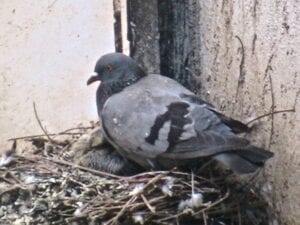
principles involved in children’s word learning.
“That’s the parallel that we’re pursuing,” he says, “but a single project—however innovative it may be—will not suffice to answer such a provocative question.”
National Institute of Mental Health, National Eye Institute, and National Institute of Deafness and Other Communication Disorders supported the research.
Pigeon Patrol Products & Services is the leading manufacturer and distributor of bird deterrent (control) products in Canada. Pigeon Patrol products have solved pest bird problems in industrial, commercial, and residential settings since 2000, by using safe and humane bird deterrents with only bird and animal friendly solutions. At Pigeon Patrol, we manufacture and offer a variety of bird deterrents, ranging from Ultra-flex Bird Spikes with UV protection, Bird Netting, 4-S Bird Gel and the best Ultrasonic and audible sound devices on the market today.
Voted Best Canadian wholesaler for Bird Deterrent products ten years in a row.
Contact us at 1- 877– 4– NO-BIRD, (604) 585-9279 or visit our website at www.pigeonpatrol.ca
Pigeon/Pigeon Patrol / Pigeons Roosting / Vancouver Pigeon Control /Bird Spikes / Bird Control / Bird Deterrent / Pigeon Deterrent? Surrey Pigeon Control / Pest /Seagull deterrent / Vancouver Pigeon Blog / Birds Inside Home / Pigeons in the cities / Ice Pigeons/ What to do about pigeons/ sparrows , Damage by Sparrows, How To Keep Raccoons Away, Why Are Raccoons Considered Pests/ De-fence / Pigeon Nesting/ Bird Droppings / Pigeon Dropping/ woodpecker control/ Professional Bird Control Company/ Keep The Birds Away/ Birds/rats/ seagull/pigeon/woodpecker/ dove/sparrow/pidgeon control/pidgeon problem/ pidgeon control/flying rats/ pigeon Problems/ bird netting/bird gel/bird spray/bird nails/ bird guard

by Pigeon Patrol | Apr 18, 2021 | Bird Law, Pigeons in the News
The CIA assassinated John F. Kennedy after he refused to kill and replace billions of birds with drones. The U.S. government is sequestering a team of Boeing engineers in Area 51 for a secret military mission. Our tax dollars have been funneled into building the “Turkey X500,” a robot used to hunt large birds.
Combine all these conspiracies and you get Birds Aren’t Real, a nearly two-year-old movement that claims the CIA took out 12 billion feathered fugitives because directors within the organization were “annoyed that birds had been dropping fecal matter on their car windows.” The targets were eradicated between 1959 and 1971 with specially altered B-52 bombers stocked with poison. They were then supplanted with avian-like robots that could be used to surveil Americans.
Sounds extreme but also somewhat fitting, given the landscape of today’s social discourse. By surfacing murky bits of history and the ubiquity of Aves, Birds Aren’t Real feeds into this era of post-truth politics. The campaign relies on internet-fueled guerilla marketing to spread its message, manifesting through real-world posters and Photoshopped propaganda tagged with the “Birds Aren’t Real” slogan.
For much of its devoted fanbase, Birds Aren’t Real is a respite from America’s political divide—a joke so preposterous both conservatives and liberals can laugh at it. But for a few followers, this movement is no more unbelievable than QAnon, a right-wing conspiracy theory turned marketing ploy that holds that someone with high-level government clearance is planting coded tips in the news. Therein lies the genius of Birds Aren’t Real: It’s a digital breadcrumb trail that leads to a website that leads to a shop full of ready-to-buy merchandise.

The creative muscle behind the avian-inspired conspiracy (and thinly disguised marketing scheme) is 20-year-old Peter McIndoe, an English and philosophy major at the University of Memphis in Tennessee. McIndoe first went live with Birds Aren’t Real in January 2017 at his city’s Women’s March. A video from the event shows McIndoe with a crudely drawn sign, heckling protesters with lines like, “Birds are a myth; they’re an illusion; they’re a lie. Wake up America! Wake up!” The idea of selling Birds Aren’t Real goods, he says, came after the stunt gained traction over Instagram.
McIndoe didn’t break character once during a 30-minute-long phone interview with Audubon. He defended the movement’s legitimacy, mainly by proselytizing about what Birds Aren’t Real isn’t. “The thought that this could be used to make a satire of a dark and tense time in American culture—I find those things to be baloney,” McIndoe says.
What isn’t baloney is the attention Birds Aren’t Real has drawn on social media, thanks to an Instagram account with more than 50,000 followers, a YouTube page with more than 45,000 views, and a Twitter profile with nearly 8,500 followers. McIndoe handles all these accounts and fulfills every order for the Birds Aren’t Real goods he sells online. He declined to comment on how much money he’s made off the T-shirts, hats, and stickers, many of which are out of stock.
Exploiting conspiracists for profit is nothing new, says Mike Metzler, a social media influencer and viral-content creator on Instagram. Amazon sells dozens of styles of QAnon T-shirts that have become a fixture at Make America Great Again rallies around the country. What’s different is that while many QAnon believers wear their shirts in earnest, most Birds Aren’t Real fans seem to wear theirs to be ironic and on trend.
“Birds Aren’t Real is taking advantage of the meme-ification of previous conspiracy theories,” Metzler says. “People really want to believe in conspiracies—but more than that, people want to make fun of people who believe in conspiracies even more. Starting a conspiracy theory and selling Birds Aren’t Real merchandise allows them to sell to both sides,” Metzler says.
McIndoe’s movement got a free jolt of publicity on October 30 after Chicago-based journalist Robert Loerzel tweeted a photo of a Birds Aren’t Real flier he found on the street. The same flier also popped up on Reddit numerous times over the past month. The hectic and cryptic nature of the website makes it an incubator for conspiracy theories like QAnon. The Reddit forum r/conspiracy has 721,000 anonymous subscribers alone.
While some people will draw parallels between QAnon and Birds Aren’t Real (they were both launched in 2017, after all), their popularity on Reddit is the only true similarity, says Brooke Binkowski, managing editor of the myth-busting website TruthOrFiction.com and the former managing editor of Snopes. “Birds Aren’t Real is a good one, but it in no way ranks up there with the incredible complexity of whatever QAnon is,” she says over email. “QAnon has caught on because it’s interactive, it’s always evolving, and it’s completely vague—so vague that anything they say could be ‘true’ if you interpret it the right way.”
How could Birds Aren’t Real gain more dark-web cred then? “Conspiracy theories offer a way for the world to make sense, and they offer a sense of purpose to the purposeless,” Binkowski writes. “If Birds Aren’t Real hinted at some larger, dark pattern, it would really take flight.”
For now, though, this shallow conspiracy seems harmless and may even be a net gain for birds. Jordan Rutter, the director of public relations at the American Bird Conservancy, thinks the intricate history behind McIndoe’s movement is hilarious and thus, something positive. “Anything that gets people talking about birds is a good thing,” she says. “It’s definitely a way we can start a conversation.”
The filmmaker Oliver Stone once wrote that Kennedy’s assassination is “a mystery wrapped in a riddle inside an enigma.” Birds Aren’t Real, on the other hand, is a chimera of conspiracies that wraps satire, modern insecurities, and internet culture into a successful marketing scheme.
Source
Pigeon Patrol Products & Services is the leading manufacturer and distributor of bird deterrent (control) products in Canada. Pigeon Patrol products have solved pest bird problems in industrial, commercial, and residential settings since 2000, by using safe and humane bird deterrents with only bird and animal friendly solutions. At Pigeon Patrol, we manufacture and offer a variety of bird deterrents, ranging from Ultra-flex Bird Spikes with UV protection, Bird Netting, 4-S Bird Gel and the best Ultrasonic and audible sound devices on the market today.
Voted Best Canadian wholesaler for Bird Deterrent products ten years in a row.
Contact us at 1- 877– 4– NO-BIRD, (604) 585-9279 or visit our website at www.pigeonpatrol.ca
Pigeon/Pigeon Patrol / Pigeons Roosting / Vancouver Pigeon Control /Bird Spikes / Bird Control / Bird Deterrent / Pigeon Deterrent? Surrey Pigeon Control / Pest /Seagull deterrent / Vancouver Pigeon Blog / Birds Inside Home / Pigeons in the cities / Ice Pigeons/ What to do about pigeons/ sparrows , Damage by Sparrows, How To Keep Raccoons Away, Why Are Raccoons Considered Pests/ De-fence / Pigeon Nesting/ Bird Droppings / Pigeon Dropping/ woodpecker control/ Professional Bird Control Company/ Keep The Birds Away/ Birds/rats/ seagull/pigeon/woodpecker/ dove/sparrow/pidgeon control/pidgeon problem/ pidgeon control/flying rats/ pigeon Problems/ bird netting/bird gel/bird spray/bird nails/ bird guard
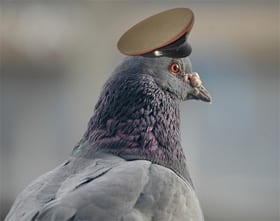
by Pigeon Patrol | Apr 18, 2021 | history of pigeons, Pigeons
 Seventy years ago a carrier pigeon performed the act of “heroism” that saw it awarded the animal’s equivalent of the Victoria Cross – the Dickin Medal. It was the first of of dozens of animals honoured by veterinary charity PDSA during World War II.
Seventy years ago a carrier pigeon performed the act of “heroism” that saw it awarded the animal’s equivalent of the Victoria Cross – the Dickin Medal. It was the first of of dozens of animals honoured by veterinary charity PDSA during World War II.
On 23 February 1942, a badly damaged RAF bomber ditched into the North Sea.
The crew were returning from a mission over Norway, but their Beaufort Bomber had been hit by enemy fire and crashed into the sea more than 100 miles from home.
Struggling in freezing waters – unable to radio an accurate position back to base – the four men faced a cold and lonely death.
But as the aircraft went down, the crew had managed to salvage their secret weapon – a carrier pigeon. The blue chequered hen bird, called Winkie, was set free in the hope it could fly home to its loft in Broughty Ferry, near Dundee, and so alert air base colleagues to their predicament.
During World War II, carrier pigeons were routinely carried by RAF bombers for this very eventuality, though in an era before GPS and satellite locator beacons, rescue was far from certain.
But Winkie did make it home, after flying 120 miles, and was discovered, exhausted and covered in oil by owner George Ross who immediately informed RAF Leuchars in Fife.
The pigeon was not carrying a message, but the RAF were able to calculate the position of the downed aircraft using the time difference between the plane’s ditching and the arrival of the bird – taking into account the wind direction and even the impact of the oil on Winkie’s feathers to her flight speed.
A rescue mission was launched and the men were found within 15 minutes.
Elaine Pendlebury, from the PDSA, said the carrier pigeon had been released as a “last ditch stand” when the crew realised they had no other options.
“I find it very, very moving really. These people would have died without this pigeon message coming through,” said Ms Pendlebury.
Winkie became the toast of the air base, with a dinner held in her honour. A year later, she became the first animal to receive the Dickin Medal – named after PDSA’s founder Maria Dickin – for “delivering a message under exceptional difficulties”.
More than 60 animals have since received the award, including 18 dogs, three horses and one cat. But pigeons still rule the medal roost, with 32 being given medals, all between 1943 and 1949.
Top secret messages
“It’s very hard for us with mobile phones and emails and things like that to think about the way communication would have happened in the 1940s in wartime,” Ms Pendlebury told BBC Scotland.
“It was very difficult and the pigeons certainly saved numerous lives by flying through really dreadful situations.”
One pigeon, called GI Joe, was an American bird which saved more than 1,000 lives when it got a message through that a village about to be bombed had actually been recaptured by British forces. Another – Mary of Exeter – was used to send top secret messages and received 22 stitches after being injured in the course of her duties.
“I’ve been a veterinary surgeon for quite some time but I find the ones that have won the PDSA Dickin medal, the stories are quite inspiring – above and beyond really,” Ms Pendlebury added.
“The message that’s on the medal is ‘We Also Serve’, which sums it up really.”
Source
Pigeon Patrol Products & Services is the leading manufacturer and distributor of bird deterrent (control) products in Canada. Pigeon Patrol products have solved pest bird problems in industrial, commercial, and residential settings since 2000, by using safe and humane bird deterrents with only bird and animal friendly solutions. At Pigeon Patrol, we manufacture and offer a variety of bird deterrents, ranging from Ultra-flex Bird Spikes with UV protection, Bird Netting, 4-S Bird Gel and the best Ultrasonic and audible sound devices on the market today.
Voted Best Canadian wholesaler for Bird Deterrent products ten years in a row.
Contact us at 1- 877– 4– NO-BIRD, (604) 585-9279 or visit our website at www.pigeonpatrol.ca
Pigeon/Pigeon Patrol / Pigeons Roosting / Vancouver Pigeon Control /Bird Spikes / Bird Control / Bird Deterrent / Pigeon Deterrent? Surrey Pigeon Control / Pest /Seagull deterrent / Vancouver Pigeon Blog / Birds Inside Home / Pigeons in the cities / Ice Pigeons/ What to do about pigeons/ sparrows , Damage by Sparrows, How To Keep Raccoons Away, Why Are Raccoons Considered Pests/ De-fence / Pigeon Nesting/ Bird Droppings / Pigeon Dropping/ woodpecker control/ Professional Bird Control Company/ Keep The Birds Away/ Birds/rats/ seagull/pigeon/woodpecker/ dove/sparrow/pidgeon control/pidgeon problem/ pidgeon control/flying rats/ pigeon Problems/ bird netting/bird gel/bird spray/bird nails/ bird guard
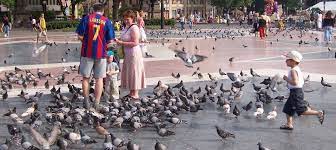
by Pigeon Patrol | Apr 18, 2021 | history of pigeons, Pigeons
Authorities in the Spanish city of Cádiz have come up with a plan for their booming pigeon population – relocating some 5,000 birds.
The city is plagued by thousands of the birds and their associated waste – but officials did not want to poison them.
Instead, the plan is to capture thousands of pigeons and relocate them hundreds of miles away in a different region – and hope they do not return.
Local officials said it was a “more respectful and sustainable” solution.
Speaking to local newspaper Diario de Cádiz, councillor Álvaro de la Fuente said “managing the population of existing pigeons does not imply the eradication of them within the urban area.”
Instead, he said a “logical balance” between the birds, humans, and other city-dwelling species was the goal.
The common pigeon is known for its location awareness – the famous homing pigeon used to carry war-time messages is a variant of the species.
But unlike their trained counterparts, the wild birds are often happy to settle in one local area – and officials in Cádiz hope that will be the case when all 5,000 pigeons are placed in their new home.
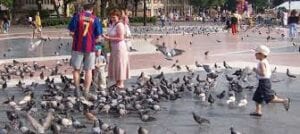
The thousands of birds to be relocated will be trapped, catalogued, and tested before being carried at least 170 miles (275km) away for release. Every bird will also get a health check along the way.
But pigeons breed quickly – so the city plans to print thousands of leaflets reminding the public not to overfeed the remaining flock, which helps to inflate the population.
In London’s Trafalgar Square, where the tradition of deliberately feeding the birds was immortalised in Disney’s Mary Poppins film, the birds flocked in great numbers until the early 2000s.
A combination of banning the feed sellers and a hefty fine on those who feed the flock anyway was part of the solution – while the introduction of hawks was another.
Today, a professional falconer accompanies a Harris hawk or peregrine falcon to Trafalgar Square several times a week – a natural predator which warns off the less welcome, smaller bird.
The same technique is used at a number of other London landmarks including BBC Broadcasting House and the Wimbledon tennis complex. It scares the birds away from one area and disperses them more widely – but does not affect the actual population much.
Source
Pigeon Patrol Products & Services is the leading manufacturer and distributor of bird deterrent (control) products in Canada. Pigeon Patrol products have solved pest bird problems in industrial, commercial, and residential settings since 2000, by using safe and humane bird deterrents with only bird and animal friendly solutions. At Pigeon Patrol, we manufacture and offer a variety of bird deterrents, ranging from Ultra-flex Bird Spikes with UV protection, Bird Netting, 4-S Bird Gel and the best Ultrasonic and audible sound devices on the market today.
Voted Best Canadian wholesaler for Bird Deterrent products ten years in a row.
Contact us at 1- 877– 4– NO-BIRD, (604) 585-9279 or visit our website at www.pigeonpatrol.ca
Pigeon/Pigeon Patrol / Pigeons Roosting / Vancouver Pigeon Control /Bird Spikes / Bird Control / Bird Deterrent / Pigeon Deterrent? Surrey Pigeon Control / Pest /Seagull deterrent / Vancouver Pigeon Blog / Birds Inside Home / Pigeons in the cities / Ice Pigeons/ What to do about pigeons/ sparrows , Damage by Sparrows, How To Keep Raccoons Away, Why Are Raccoons Considered Pests/ De-fence / Pigeon Nesting/ Bird Droppings / Pigeon Dropping/ woodpecker control/ Professional Bird Control Company/ Keep The Birds Away/ Birds/rats/ seagull/pigeon/woodpecker/ dove/sparrow/pidgeon control/pidgeon problem/ pidgeon control/flying rats/ pigeon Problems/ bird netting/bird gel/bird spray/bird nails/ bird guard


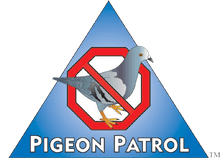

 principles involved in children’s word learning.
principles involved in children’s word learning.


